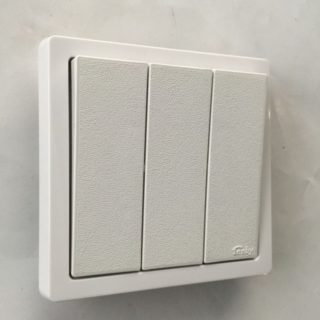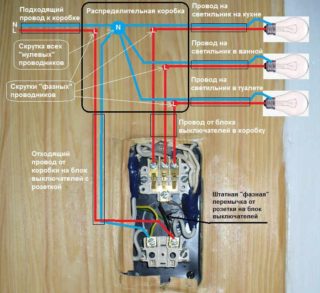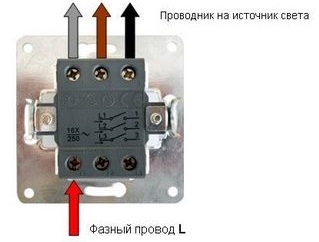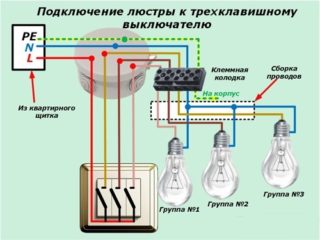When arranging home electrical wiring or repairing it, you need to know exactly how to connect a three-button switch to an existing lighting network. It follows from how many luminaires are supposed to be used in a given line and how to rationally distribute three key mechanisms for individual loads. To understand how 3 rocker switches are connected, you will need to familiarize yourself with their design and specific application.
Design and application features

Structurally, the 3-key switch is a standard rocker-type mechanism, consisting of three identical units. When you change the position of one button-key (when you press it to the upper edge), the internal commutator closes this chain. When pressed on its lower part, the system returns to its original state when the electrical circuit is open.
The same processes occur when the remaining two buttons of the three-button device are pressed.
The design feature of this mechanism is that its lower contacts are combined into one block, to which a common phase wire is connected. And the upper terminals are made separate, which allows you to connect three different loads to them.
The standard connection of a 3-way switch assumes the following switching options:
- When one of the keys is pressed, the phase voltage is supplied only to the circuit extending from the corresponding contact towards the load. A separate light bulb or a group of fixtures is connected.
- If you press two buttons at once - 220 Volts are switched to wires that are connected to two lamps of a chandelier, for example.
- When all key mechanisms are transferred to the upper position, the phase is fed immediately to three load lines with lamps included in them.
After moving the entire changeover system to the lower position, the voltage from the upper electrical contacts of the switch is completely removed. All the lamps of the chandelier controlled with it go out.
The three-key switch can be switched on in different ways and be activated either partially or completely. The latter case is in demand when it is necessary to increase the illumination of the room to the maximum.
The order and schemes of inclusion

The procedure for laying and connecting conductors suitable for the switch depends on the way it is connected to the switched circuit. According to the connection diagrams used for light switches with three buttons, the following options are possible:
- Only a phase conductor is connected to the device, which is switched to three different loads. The zero core was laid to the chandelier from a nearby junction box during the construction phase.
- For connection, a phase wire is used, which goes along with the zero core from the nearest outlet.
In the first case, the lead wire is walled up into the wall (with hidden electrical wiring), and its end protrudes outward. Its length must be sufficient to allow the end to be connected to the common terminal of the switch. The three outgoing conductors are routed along the wall surface up to the appropriate load through the junction box.
The second method is used when connecting triple switches with a socket in old houses, where full-fledged junction boxes are often absent.In their place, a plastic box with twists placed inside is installed under the ceiling.
In this scheme, both phase and zero are taken from the outlet, and the latter is laid bypassing the switch and, together with the phase conductor, is supplied to the existing twist. From there, they are crossed together to the lighting fixture. When making connections in a junction box or twisting, you need to carefully monitor the color of the insulation of the conductors that are suitable and outgoing towards the luminaire.
Neutral conductors usually have blue (blue) insulation, and the protective coating of the phase conductors is either red or brown in color. The switching of a pair of power contacts is carried out strictly in compliance with the color marking.
Regardless of the circuit according to which the switch is to be connected, it can be used for the following needs:
- Connection of a separate chandelier with three or more lamp groups.
- Switching the operation of spotlights or lighting elements (based on an LED strip, for example).
- Lighting control in three rooms from one remote location (a corridor is usually chosen for this purpose).
It is necessary to consider the main of the proposed options in more detail.
Connecting a chandelier and three rooms
When connecting a chandelier operated in a particular room to a three-button switch, the following methods of switching individual bulbs are possible:
- For each horn, voltage is supplied from one of the upper contacts of the push-button device, which allows them to be switched on separately or together.
- If desired, three bulbs can be switched according to different schemes ("1 plus 2", for example), one combination is switched on from one contact, and another from the second.
- Inclusion, practiced when using 5, 6 or more bulbs in the chandelier. They are all divided into groups.
When lighting control in three adjacent (not walk-through) rooms in an apartment or private house, the switch is placed in a common corridor not far from its exit. In this case, the lighting, if necessary, is switched on in one of the rooms, in two rooms, or in all at once.
Connection errors

Before replacing a three-key switch in your apartment, it is advisable to familiarize yourself with the typical mistakes made during this operation. The main violations in connecting a new device:
- The phase wire is not connected from below, but from above the switch, which is considered unacceptable and will require alteration.
- The switch is not built into the phase line, but into the neutral circuit. This is a gross violation of the requirements of the PUE and can lead to an accident (electric shock).
- The wires leaving the switch are not connected to the lighting fixture through a junction box, but directly.
The latter violation will lead to the inconvenience of redistributing individual lighting groups when the need arises, for example, when repairing or replacing a chandelier.
When using a three-key device for switching lighting in three rooms, it is sometimes mistakenly installed on passage-type rooms. For "through" rooms, this type of connection is not suitable; you will need special through-type switches.









